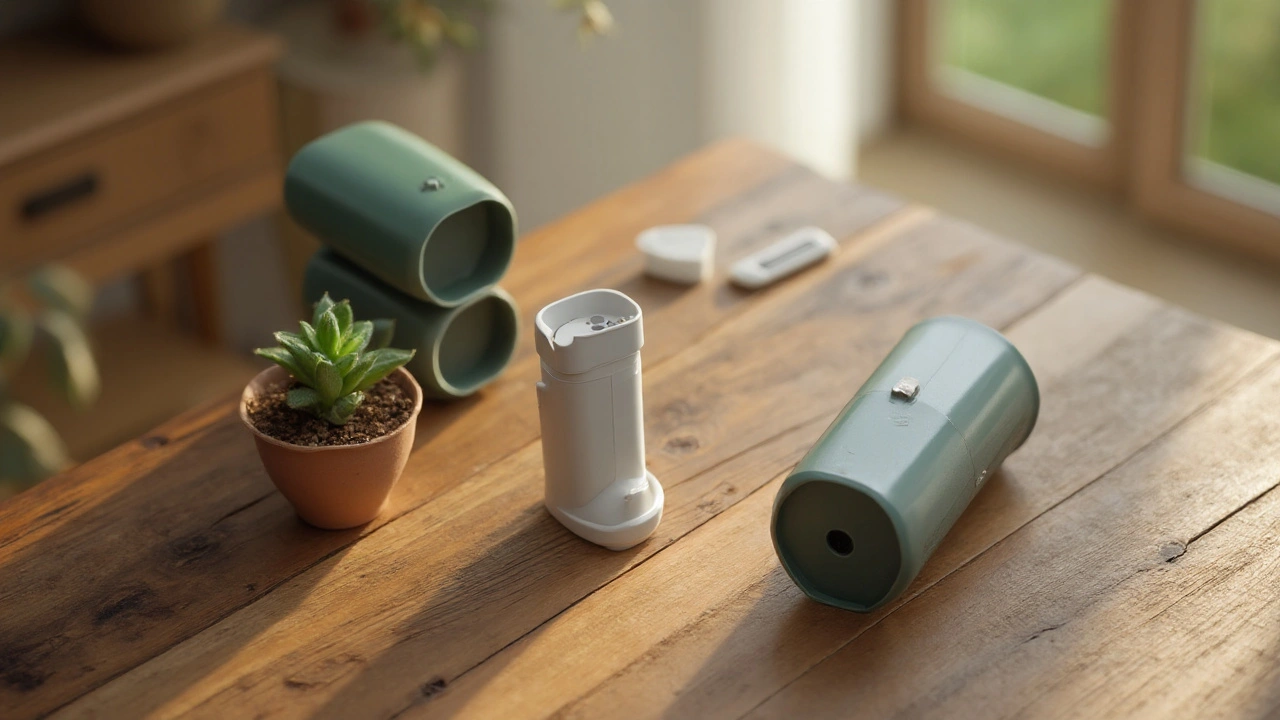Inhaler Carbon Footprint Calculator
Beclomethasone inhaler is a metered‑dose inhaler (MDI) that delivers the corticosteroid beclomethasone dipropionate to the lungs for asthma or COPD management. It combines the active drug with a hydrofluoroalkane (HFA) propellant, creating a convenient, press‑urized spray. While clinically effective, the device carries a hidden climate cost that many patients overlook.
Why the Environmental Question Matters
Healthcare contributes roughly 4‑5% of global greenhouse‑gas emissions, according to the World Health Organization. Inhalers, especially those using HFA propellants, are a surprisingly large slice of that pie. Each puff releases a tiny amount of propellant, but the cumulative effect of millions of inhalers worldwide adds up to kilograms of CO₂‑equivalent per year.
How a Beclomethasone Inhaler Works
The device consists of three core components:
- A hydrofluoroalkane (HFA) propellant - typically HFA‑134a, with a global warming potential (GWP) of around 1,300.
- An canister that holds the drug‑propellant mixture under pressure.
- A metered‑dose valve that releases a precise 100µg dose of beclomethasone per actuation.
When you press the inhaler, a fraction of the propellant expands, turning liquid drug into an aerosol that travels into the airways.
Life‑Cycle Emissions: From Factory to Trash
Environmental impact isn’t limited to the propellant released during use. A full life‑cycle assessment (LCA) includes raw‑material extraction, manufacturing, distribution, patient use, and end‑of‑life disposal. Studies from the University of Nottingham show that the manufacturing phase accounts for roughly 10% of an MDI’s total carbon footprint, while the propellant contributes the remaining 90%.
Comparing Inhaler Technologies
| Device | Propellant | GWP per Actuation | Typical Carbon Footprint (kg CO₂e per canister) |
|---|---|---|---|
| MDI (beclomethasone) | HFA‑134a | ~0.05g CO₂e | ≈500 |
| Dry‑powder inhaler (DPI) | None (mechanical) | ~0g CO₂e | ≈20 |
| Soft‑mist inhaler | None (water‑based) | ~0g CO₂e | ≈30 |
Dry‑powder inhalers (DPIs) and soft‑mist inhalers avoid HFA completely, slashing the carbon footprint by more than 95% compared with a typical beclomethasone MDI.

Regulatory and Industry Moves Toward Greener Inhalers
In 2022, the European Medicines Agency endorsed a target to cut inhaler‑related emissions by 50% by 2030. Pharmaceutical giants such as GlaxoSmithKline and AstraZeneca have invested in low‑GWP propellants (e.g., HFA‑152a, GWP≈124) and are testing plastic‑free canisters. The US FDA’s 2024 draft guidance encourages manufacturers to disclose inhaler carbon footprints on product labels.
Practical Steps for Patients
- Ask your prescriber about DPI alternatives. If your disease control is stable, many clinicians are comfortable switching to a DPI with the same dose.
- Enroll in an inhaler recycling program. Pharmacy chains in the UK, Canada, and parts of the US collect used MDIs for safe propellant recovery.
- Use each inhaler to its full life span. Wasting a partially used canister not only increases cost but also adds unnecessary emissions.
- Consider proper disposal: do not throw MDIs in regular trash. Many local waste‑management services treat them as hazardous waste.
Future Outlook: Low‑Impact Propellants and Innovative Designs
Research into HFA‑152a and HFO‑1234ze(E) aims to bring GWP values under 200, a dramatic reduction from HFA‑134a. Some prototypes combine a low‑GWP propellant with a reusable cartridge, letting patients replace only the drug cartridge while keeping the canister.
Another promising direction is the development of “dose‑smart” inhalers that attach to smartphones, ensuring each actuation is recorded. Accurate dosing reduces over‑use, indirectly cutting emissions.
Bottom Line for Eco‑Conscious Users
While the beclomethasone inhaler remains a lifesaver for many, its environmental cost is measurable and actionable. Switching to a DPI, recycling used MDIs, and staying informed about low‑GWP innovations can collectively shrink the inhaler carbon footprint without compromising health.
Frequently Asked Questions
How much CO₂ does a single beclomethasone inhaler release?
A typical beclomethasone MDI contains about 500kg CO₂‑equivalent, mostly from the HFA‑134a propellant released during use.
Are dry‑powder inhalers as effective as MDIs?
For most patients with mild‑to‑moderate asthma, DPIs provide comparable disease control. However, patients with very low inspiratory flow may still need an MDI.
Can I recycle my beclomethasone inhaler at any pharmacy?
Many large pharmacy chains run take‑back schemes, but availability varies by region. Check with your local pharmacist for the nearest drop‑off point.
What low‑GWP propellants are being tested?
HFA‑152a (GWP≈124) and HFO‑1234ze(E) (GWP≈6) are the leading candidates. Early clinical trials show they can deliver the same aerosol performance as HFA‑134a.
Will switching inhalers affect my insurance coverage?
Most insurers cover approved DPIs and soft‑mist devices at parity with MDIs. It’s best to confirm with your pharmacy benefits manager before making a switch.


Corine Wood
It's staggering how little we think about the environmental toll of daily medical devices. I switched to a DPI last year after my pulmonologist mentioned the carbon footprint - and honestly, it’s just as effective. No more puffing into the air like a tiny smoke machine.
Akintokun David Akinyemi
As someone from Nigeria where inhalers are still a luxury, I find it ironic that the global north is now debating their carbon footprint. Millions still don’t have access to any inhaler at all. Sustainability matters, but equity matters more.
Jake TSIS
They’re just pushing this ‘green inhaler’ nonsense to sell more expensive devices. Big Pharma’s latest scam to make you buy new gear every year.
Jasmine Hwang
i mean… do we really care about this? like, my asthma is bad enough without having to feel guilty for breathing.
Michal Clouser
Thank you for bringing this critical issue to light. While the clinical efficacy of beclomethasone MDIs remains unquestioned, the environmental implications warrant serious consideration. The life-cycle assessment data presented is compelling, and the transition toward dry-powder inhalers represents a scientifically sound and ethically responsible direction. I encourage all patients to engage with their providers regarding alternatives.
Shawn Baumgartner
Let’s be real - this is all woke environmentalism masquerading as medical advice. You want to save the planet? Stop flying, stop eating meat, stop buying plastic. But don’t tell me to switch inhalers because some PhD in Nottingham crunched numbers. My lungs don’t care about your carbon footprint.
BERNARD MOHR
Have you ever thought that maybe the government is using this to track us? Like, if every inhaler has a smart chip now… who’s collecting the data? And why do they care how many puffs you take? 😏
Brian O
Hey, I get the concern, but let’s not shame people who rely on these devices. I’ve got a cousin with severe COPD - she can’t use DPIs. The real win is pushing pharma to make better propellants, not guilt-tripping patients.
Steve Harvey
They’re hiding the truth - HFA propellants are just a distraction. The real villain? The lithium batteries in the ‘smart inhalers’ they’re pushing. Those things are full of cobalt mined by kids in Congo. You think this is green? It’s just a new kind of exploitation.
James Gonzales-Meisler
There’s a typo in the FAQ: '500kg CO₂-equivalent' should be '500g'. That’s a three-order-of-magnitude error. Please correct it before this spreads further.
Maeve Marley
I’ve been using a DPI for three years now, and I’ll never go back. The difference in carbon footprint is insane - like comparing a bicycle to a Hummer. But what really moved me was learning that recycling programs exist. I started bringing my empty canisters to CVS, and now I tell everyone I know. It’s not about perfection, it’s about participation.
There’s this quiet dignity in choosing to do better without making anyone feel bad. You don’t have to be an activist to make a difference - you just have to be willing to ask your doctor, ‘Is there another option?’
And honestly? The DPI feels more… intentional. Like you’re actually in control of your health, not just pressing a button and hoping for the best.
It’s small, but it’s something. And sometimes, that’s enough.
Navin Kumar Ramalingam
Bro, why are we even talking about this? Like, I get the carbon thing, but if you’re using a beclomethasone inhaler, you’re already in the top 1% of global health access. The real issue is people dying because they can’t afford any inhaler at all. Save your virtue signaling for something that matters.
liam coughlan
Interesting piece. I’ve seen the same data from the EMA reports. The real shift will come when insurers start covering DPIs without prior auth. Until then, patients will stick with what’s familiar - even if it’s dirtier.
Cassaundra Pettigrew
Oh, so now we’re supposed to feel guilty for breathing? Next they’ll ban oxygen tanks because of the methane emissions from the oxygen plants. This is the kind of performative activism that makes people hate environmentalists.
My kid’s life depends on this inhaler. You want to save the planet? Go protest oil rigs. Don’t tell me to stop using my medicine.
Earle Grimes61
Did you know HFA-134a was developed by a secret alliance between Big Pharma and the EPA to create a dependency cycle? They’re not trying to reduce emissions - they’re trying to force you into proprietary smart inhalers so they can monetize your breathing patterns. The ‘recycling programs’? Just a cover to collect your data. Wake up.